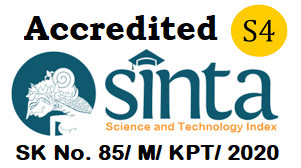Usability Analysis of Dictionary Applications About Psychological Terms Using System Usability Scale Method
Abstract
The digital dictionary of psychological terms is used to make easier for users to search for terms related to psychology. Usability is an important factor in development of application because it can be used to measure user satisfaction. This study aims to build a digital dictionary application of psychological terms and to analyze its usability level using the System Usability Scale (SUS) method. The research used 20 psychology students as respondents. The final value of SUS is 73.5 which indicates that user acceptance (acceptability ranges) is in the acceptable category, meaning that users can accept this application. The results show that the grade scale is still C. Adjective ratings are in the Good category. The test results are positive, the average score reaches 4.3 out of a scale of 5. This indicates that there is a user's desire to use the application (Q1), acknowledges the ease of use (Q3), functions/features provided are complete (Q5), optimism that the application will be used by others (Q7), and users feel confident in using this application (Q9). The results also recommend that for further development, developers need to pay attention to aspects of technical assistance in using applications (Q4), reduce inconsistencies in applications (Q6), and users feel there is still much to learn before using applications (Q10), so digital dictionary developers must improve the design / features to increase the level of user satisfaction.
References
Akour, M., Alsghaier, H. and Aldiabat, S. (2020) ‘Game-based learning approach to improve self-learning motivated students’, International Journal of Technology Enhanced Learning, 12(2), pp. 146–160. Available at: https://doi.org/10.1504/IJTEL.2020.106283.
Anwariningsih, S.H. and Anwar, A.K. (2022) Media Pembelajaran Berbasis Animasi Menggunakan Video MakerFX sebagai Pendukung Pembelajaran Daring. 1st edn. Surakarta: CV Catur Berlian Media Tama.
Anwariningsih, S.H. and Ernawati, S. (2013) ‘Development of interactive media for ict learning at elementary school based on student self learning.’, Journal of Education and Learning, 7(2), pp. 121–128.
Bangor, A., Kortum, P. and Miller, J. (2009) ‘Determining What Individual SUS Scores Mean: Adding an Adjective Rating Scale’, Journal of Usability Studies, 4(3), pp. 114–123.
Bangor, A., Kortum, P.T. and Miller, J.T. (2008) ‘An Empirical Evaluation of the System Usability Scale’, International Journal of Human-Computer Interaction, 24(6), pp. 574–594. Available at: https://doi.org/10.1080/10447310802205776.
Brooke, J. (1996) ‘SUS - A Quick and Dirty Usability Scale’, in P.W. Jordan et al. (eds) Usability evaluation in industry. London: Taylor & Francis, pp. 189–194. Available at: https://doi.org/10.5948/upo9781614440260.011.
Brooke, J. (2013) ‘SUS : A Retrospective’, Journal Of Usability Studies (JUS), 8(2), pp. 29–40.
Chandran, S.K. et al. (2017) ‘Sample Size in the Application of System Usability Scale to Automotive Interfaces’, SAE Technical Papers, 2017-March(March). Available at: https://doi.org/10.4271/2017-01-1383.
Fitrasari, B.D. (2021) ‘User satisfaction analysis of instant transcription application using the system usability scale (SUS) method: A case study on teenaged and adult deaf users’, Proceedings - 2021 7th International Conference on Education and Technology, ICET 2021, pp. 7–10. Available at: https://doi.org/10.1109/ICET53279.2021.9575092.
Lewis, J.R. and Sauro, J. (2018) ‘Item Benchmarks for the System Usability Scale’, Journal of Usability Studies, 13(3), pp. 158–167. Available at: https://doi.org/10.5555/3294033.3294037.
Oppong, E. et al. (2018) ‘The effect of mobile health service quality on user satisfaction and continual usage’, Total Quality Management and Business Excellence, 32(1–2), pp. 177–198. Available at: https://doi.org/10.1080/14783363.2018.1541734.
Pal, D. and Vanijja, V. (2020) ‘Perceived Usability Evaluation of Microsoft Teams as an Online Learning Platform During COVID-19 using System Usability Scale and Technology Acceptance Model in India’, Children and Youth Services Review [Preprint]. Available at: https://doi.org/10.1016/j.childyouth.2020.105535.
Ratnawati, S. (2020) ‘Evaluation of Digital Library’s Usability Using the System Usability Scale Method of (A Case Study)’, 2020 8th International Conference on Cyber and IT Service Management, CITSM 2020 [Preprint]. Available at: https://doi.org/10.1109/CITSM50537.2020.9268801.
Sharfina, Z. and Santoso, H.B. (2016) ‘An Indonesian Adaptation of the System Usability Scale (SUS)’, in International Conference on Advanced Computer Science and Information Systems, (ICACSIS 2016). Malang: IEEE, pp. 145–148. Available at: https://doi.org/10.1109/ICACSIS.2016.7872776.
Soykan, E. and Özdamlı, F. (2019) ‘Development process of instructional mobile application for special needs children’, International Journal of Technology Enhanced Learning, 11(3), pp. 259–278. Available at: https://doi.org/10.1504/IJTEL.2019.100482.
Weichbroth, P. (2020) ‘Usability of Mobile Applications: A Systematic Literature Study’, IEEE Access, 8, pp. 55563–55577. Available at: https://doi.org/10.1109/ACCESS.2020.2981892.
Zainuddin, N.M.M. (2022) ‘Measuring Satisfaction on Augmented Reality Courseware for Hearing-Impaired Students: Adjustment Formula form System Usability Scale’, Asian Journal of University Education, 18(2), pp. 348–360. Available at: https://doi.org/10.24191/ajue.v18i2.17990.
Zaranis, N. and Exarchakos, G.M. (2018) ‘Does ICT affect the understanding of ellipsoids, cylinders and cones among students from University of Applied Sciences?’, International Journal of Technology Enhanced Learning, 10(4), pp. 269–288. Available at: https://doi.org/10.1504/IJTEL.2018.095123.

This work is licensed under a Creative Commons Attribution-NonCommercial-ShareAlike 4.0 International License.













